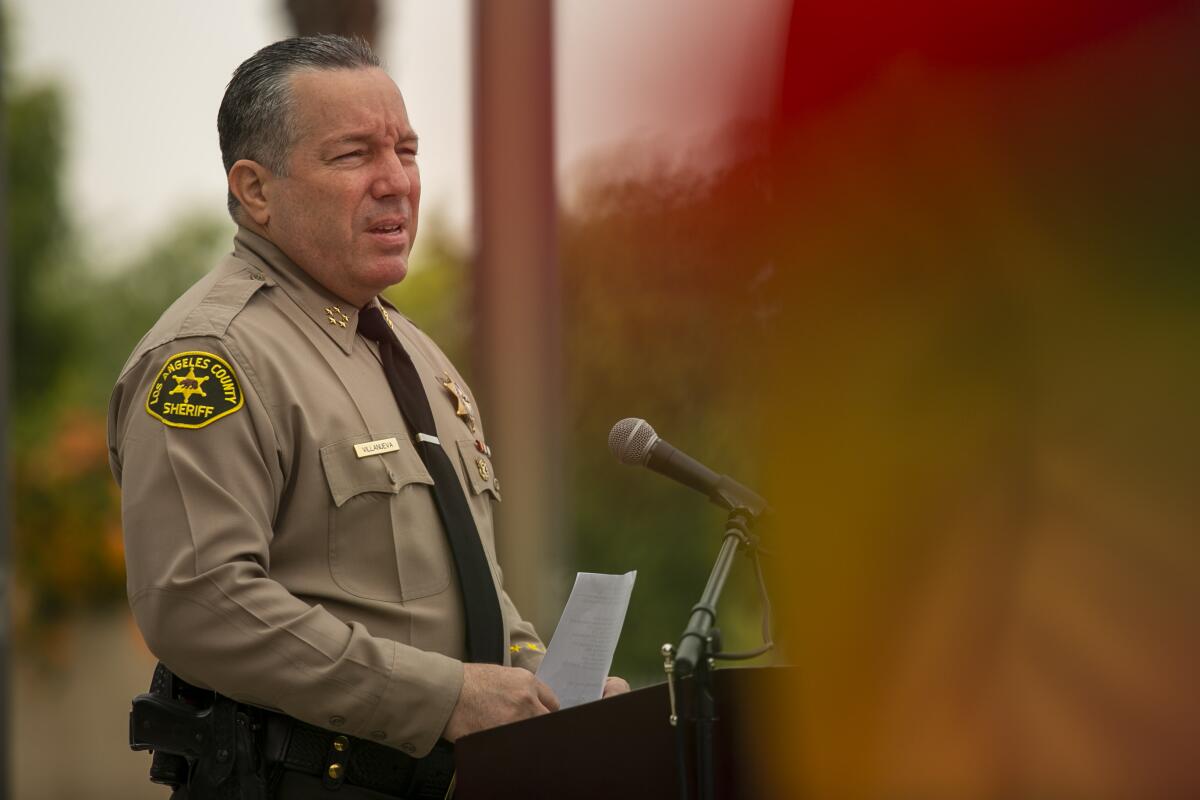Detective’s ‘end run’ to seal autopsy deepens divisions between L.A. County sheriff and coroner

- Share via
A Los Angeles County Sheriff’s Department homicide detective quietly approached a Superior Court judge late last month with an unusual request: He wanted the judge to bar the county’s coroner from releasing the autopsy report on a man killed by sheriff’s deputies.
In normal times, a judge would have had no reason to get involved. The office of the medical examiner-coroner had always kept reports secret whenever investigators from the Sheriff’s Department or any other police agency asked.
But these are not normal times in L.A. County, where Sheriff Alex Villanueva is locked in an increasingly hostile power struggle with county officials who accuse him of undoing critical reforms, shunning transparency and rebuffing efforts to hold him accountable. The friction has spilled over in recent months to the office of the medical examiner-coroner, where senior staffers have made it clear that the old rules no longer apply when it comes to killings by sheriff’s deputies.
The judge signed off on the gag order, setting in motion a legal tussle that has further isolated the sheriff from other county leaders and deepened the feud with the coroner.
The current skirmish with the coroner stems from a clash in mid-July, when the coroner broke ranks with the Sheriff’s Department by releasing the autopsy report of Andres Guardado, confirming that the 18-year-old was shot by a deputy five times in the back.
Sheriff’s Department investigators had asked the coroner to keep the report under wraps, saying the information about how Guardado died could taint their investigation if it was made public. Such requests are not unusual in high-profile cases, including those in which someone is killed by a police officer. The result is that information about cases can remain cloaked in secrecy for months or, in some cases, years.
Villanueva was incensed by the coroner’s move to release the report, which he believed could jeopardize the investigation into the deputy’s actions. He suggested that, going forward, his investigators would have to seek court orders to make the coroner adhere to the information blackouts, which are referred to as security holds.
Since Guardado’s report was released, L.A. County sheriff’s deputies have fatally shot five other people, according to information compiled by the department. The one that would lead to the legal battle with the coroner was the shooting of Dana Young in the early morning hours of Oct. 15.
Deputies responded to a call of a woman being kidnapped at gunpoint in South L.A., according to a news release from the Sheriff’s Department.
Young forced a woman into his SUV and fled, the release said. At one point, the driver of the SUV stopped and fired at the woman’s friend, who had given chase.
The woman managed to escape, and as deputies closed in, the SUV crashed into a gate at the end of a cul-de-sac.
Young was running when deputies opened fire, the department said. There were no details on what prompted the shooting.
Young died at the scene. A gun was recovered.
As is done with all killings by deputies, sheriff’s detectives began investigating the shooting. Intent on not having the coroner’s office once again go public with its findings, Det. Jason Marx went to Superior Court Judge Kerry L. White on Oct. 29 and came away with an order that barred the coroner from releasing Young’s autopsy report for 60 days. Later that day, Marx presented it to the coroner’s office.
Coroner’s officials objected. In a declaration filed in court, Chief Medical Examiner-Coroner Dr. Jonathan Lucas said that no one from the Sheriff’s Department had requested a security hold on Young’s autopsy and that Marx had not notified the coroner’s office beforehand about his plan to seek a court order.
Lawyers for the county, who typically go to court to defend the Sheriff’s Department, not oppose it, asked the judge to throw out the order, arguing that it was void because the coroner’s office wasn’t given notice and that it “impermissibly restricted” the county’s ability to operate as intended.
In an apparent reference to the Guardado case, the lawyers argued Marx “decided to make an end run” around the coroner’s office because “he may have been unhappy” that it had defied a security hold in an unrelated case, according to the filing.
“Detective Marx simply had no factual or legal basis to apply for the Order, and the Court had no basis to grant it,” county attorneys wrote in their filing.
Marx and an attorney who appeared in court on his behalf did not return calls for comment, but a Sheriff’s Department spokesman said investigators were “concerned with the precedent” the coroner had set in the Guardado case and so went to the judge.
“Transparency is a goal, however, it cannot come at the expense of the integrity of the investigation,” Lt. John Satterfield said in a statement.
White, the judge who signed the initial order, declined to comment through his court clerk.
Ultimately, another judge decided the issue. It’s unclear why White did not. At a hearing Tuesday at the East L.A. Courthouse, Judge Lucy Armendariz vacated White’s order, deciding that “neither Detective Jason Marx nor anyone from the Los Angeles County Sheriff’s Department may rely upon or transmit or cite the order to anyone as an extant order.”
The court filings also reveal new details about the Guardado case and the heated back-and-forth between the coroner’s office and the Sheriff’s Department that ended with the release of the autopsy report.
In July, three weeks after the 18-year-old was killed, sheriff’s investigators still had not formally interviewed the deputy who had opened fire.
Attorneys representing Guardado’s family had released the results of an independent autopsy that concluded he had been shot five times in the back. His death had generated national attention and large protests, adding to a summer of unrest across the country over police brutality.
Homicide Bureau Capt. Kent Wegener, whose detectives were conducting the criminal investigation, sent a letter to the coroner, asking him to keep the official autopsy report from the public so that those who hadn’t yet been interviewed would not be influenced by the results.
“I am aware that the family of Andres Guardado has released selected excerpts of their private examination; however, we have no control over this,” he wrote in the letter, a copy of which was filed in court. “Regardless, I will not submit to releasing this confidential information from the County autopsy, contributing to a breach of confidentiality within this criminal investigation.”
Lucas, the chief medical examiner, gave the captain until the next morning to provide “specific factual information” that supported the need for secrecy, the records show.
Wegener wrote back about 20 minutes later.
“What more do you need?” he said, according to emails in the court filing. “If we provide details of the injuries to the purported witnesses, we are feeding them information which they could include in their statement. There are people asserting that [they] witnessed the encounter, including the shooting. If so, we want the details of what they witnessed before we tell them what was discovered.”
Wegener could not be reached for comment.
Lucas weighed his options and ultimately decided to publicly disclose the Guardado autopsy report two days later.
“I believe that government can do its part by being more timely and more transparent in sharing information that the public demands and has a right to see,” he said at the time.
Just this week, the coroner’s office announced that it would conduct an independent inquest, the first of its kind in nearly 30 years, into Guardado’s death. It will allow the coroner’s office to subpoena witnesses and present documents to an independent hearing officer who “will make findings related to the cause and manner of death,” according to a statement issued by the agency.
More to Read
Sign up for Essential California
The most important California stories and recommendations in your inbox every morning.
You may occasionally receive promotional content from the Los Angeles Times.














